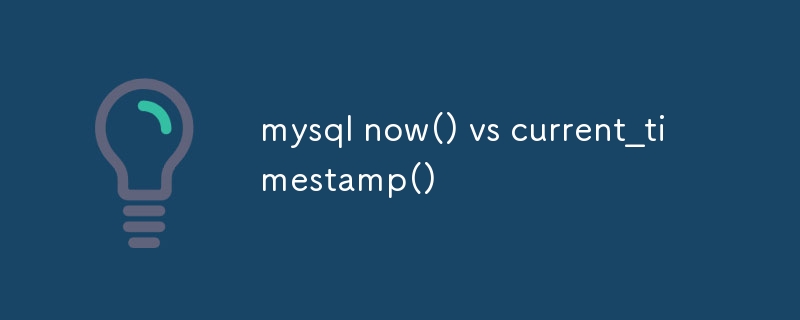The main difference between NOW() and CURRENT_TIMESTAMP() is in the usage scenario; CURRENT_TIMESTAMP can be used as a column default value and automatically update keywords, while NOW() is only a function; both return the same result in the query, but when defining the table structure, you must use CURRENT_TIMESTAMP to set the default value or automatically update the timestamp.

In MySQL, NOW() and CURRENT_TIMESTAMP() look similar and have similar functions, but there are still some nuances between them. If you just want to know the difference quickly, let’s talk about the key points first:

- Both can be used to obtain the current date and time;
-
NOW()is a function, andCURRENT_TIMESTAMP()is a keyword whose function is also a default value; - In some contexts (such as setting the default value of a column),
CURRENT_TIMESTAMPis more commonly used and recommended.
The following are some common usage scenarios.
1. Basic usage: Get the current time
The most basic function of these two functions is to return the current date and time, and the format is YYYY-MM-DD HH:MM:SS .

SELECT NOW(), CURRENT_TIMESTAMP();
The execution results are usually the same, all at the current point in time. But note that NOW() returns the time when the statement starts executing, not the time when the function is called . If NOW() is called multiple times in a long transaction, it will always return to the same point in time.
In contrast, CURRENT_TIMESTAMP() is actually synonymous with NOW() , and there is no difference in this query scenario.

2. Use as the default value of the column
This is where the two truly reflect the difference.
When you create a table and want a field to automatically record the insertion time, it is usually written like this:
CREATE TABLE example (
id INT PRIMARY KEY AUTO_INCREMENT,
created_at TIMESTAMP DEFAULT CURRENT_TIMESTAMP
);You can't write it as:
created_at TIMESTAMP DEFAULT NOW()
This will report an error. Because when defining the default value, MySQL only accepts CURRENT_TIMESTAMP form and does not support the NOW() function.
So in this scenario, CURRENT_TIMESTAMP must be used to be legal .
3. Automatically update the timestamp
In addition to the default value, MySQL also supports automatic update of timestamps when data is updated, and at this time, it also depends on CURRENT_TIMESTAMP .
CREATE TABLE example (
id INT PRIMARY KEY AUTO_INCREMENT,
updated_at TIMESTAMP DEFAULT CURRENT_TIMESTAMP ON UPDATE CURRENT_TIMESTAMP
);This definition means:
- When inserting a new record, the current time will be automatically filled in;
- When this record is updated, this field will also be automatically updated to the current time.
Similarly, ON UPDATE NOW() is not allowed, only CURRENT_TIMESTAMP can be used.
4. Small differences in time zone processing (advanced)
Although not encountered in most cases, NOW() and CURRENT_TIMESTAMP() are affected by the current connection time zone. For example, if you set the connection time zone to East Eight in the application, then the local time will be returned.
But if you deploy database services across time zones, or do replication and migration operations, you should pay attention to this point. However, the two behaviors in this regard are consistent and there is no need to be a special distinction.
In general, these two functions are interchangeable in the query, but when defining the table structure, especially the default value and automatic update, you must use CURRENT_TIMESTAMP .
Basically that's it.
The above is the detailed content of mysql now() vs current_timestamp(). For more information, please follow other related articles on the PHP Chinese website!

Hot AI Tools

Undress AI Tool
Undress images for free

Undresser.AI Undress
AI-powered app for creating realistic nude photos

AI Clothes Remover
Online AI tool for removing clothes from photos.

Clothoff.io
AI clothes remover

Video Face Swap
Swap faces in any video effortlessly with our completely free AI face swap tool!

Hot Article

Hot Tools

Notepad++7.3.1
Easy-to-use and free code editor

SublimeText3 Chinese version
Chinese version, very easy to use

Zend Studio 13.0.1
Powerful PHP integrated development environment

Dreamweaver CS6
Visual web development tools

SublimeText3 Mac version
God-level code editing software (SublimeText3)
 Connecting to MySQL Database Using the Command Line Client
Jul 07, 2025 am 01:50 AM
Connecting to MySQL Database Using the Command Line Client
Jul 07, 2025 am 01:50 AM
The most direct way to connect to MySQL database is to use the command line client. First enter the mysql-u username -p and enter the password correctly to enter the interactive interface; if you connect to the remote database, you need to add the -h parameter to specify the host address. Secondly, you can directly switch to a specific database or execute SQL files when logging in, such as mysql-u username-p database name or mysql-u username-p database name
 Handling character sets and collations issues in MySQL
Jul 08, 2025 am 02:51 AM
Handling character sets and collations issues in MySQL
Jul 08, 2025 am 02:51 AM
Character set and sorting rules issues are common when cross-platform migration or multi-person development, resulting in garbled code or inconsistent query. There are three core solutions: First, check and unify the character set of database, table, and fields to utf8mb4, view through SHOWCREATEDATABASE/TABLE, and modify it with ALTER statement; second, specify the utf8mb4 character set when the client connects, and set it in connection parameters or execute SETNAMES; third, select the sorting rules reasonably, and recommend using utf8mb4_unicode_ci to ensure the accuracy of comparison and sorting, and specify or modify it through ALTER when building the library and table.
 Implementing Transactions and Understanding ACID Properties in MySQL
Jul 08, 2025 am 02:50 AM
Implementing Transactions and Understanding ACID Properties in MySQL
Jul 08, 2025 am 02:50 AM
MySQL supports transaction processing, and uses the InnoDB storage engine to ensure data consistency and integrity. 1. Transactions are a set of SQL operations, either all succeed or all fail to roll back; 2. ACID attributes include atomicity, consistency, isolation and persistence; 3. The statements that manually control transactions are STARTTRANSACTION, COMMIT and ROLLBACK; 4. The four isolation levels include read not committed, read submitted, repeatable read and serialization; 5. Use transactions correctly to avoid long-term operation, turn off automatic commits, and reasonably handle locks and exceptions. Through these mechanisms, MySQL can achieve high reliability and concurrent control.
 Managing Character Sets and Collations in MySQL
Jul 07, 2025 am 01:41 AM
Managing Character Sets and Collations in MySQL
Jul 07, 2025 am 01:41 AM
The setting of character sets and collation rules in MySQL is crucial, affecting data storage, query efficiency and consistency. First, the character set determines the storable character range, such as utf8mb4 supports Chinese and emojis; the sorting rules control the character comparison method, such as utf8mb4_unicode_ci is case-sensitive, and utf8mb4_bin is binary comparison. Secondly, the character set can be set at multiple levels of server, database, table, and column. It is recommended to use utf8mb4 and utf8mb4_unicode_ci in a unified manner to avoid conflicts. Furthermore, the garbled code problem is often caused by inconsistent character sets of connections, storage or program terminals, and needs to be checked layer by layer and set uniformly. In addition, character sets should be specified when exporting and importing to prevent conversion errors
 Using Common Table Expressions (CTEs) in MySQL 8
Jul 12, 2025 am 02:23 AM
Using Common Table Expressions (CTEs) in MySQL 8
Jul 12, 2025 am 02:23 AM
CTEs are a feature introduced by MySQL8.0 to improve the readability and maintenance of complex queries. 1. CTE is a temporary result set, which is only valid in the current query, has a clear structure, and supports duplicate references; 2. Compared with subqueries, CTE is more readable, reusable and supports recursion; 3. Recursive CTE can process hierarchical data, such as organizational structure, which needs to include initial query and recursion parts; 4. Use suggestions include avoiding abuse, naming specifications, paying attention to performance and debugging methods.
 Strategies for MySQL Query Performance Optimization
Jul 13, 2025 am 01:45 AM
Strategies for MySQL Query Performance Optimization
Jul 13, 2025 am 01:45 AM
MySQL query performance optimization needs to start from the core points, including rational use of indexes, optimization of SQL statements, table structure design and partitioning strategies, and utilization of cache and monitoring tools. 1. Use indexes reasonably: Create indexes on commonly used query fields, avoid full table scanning, pay attention to the combined index order, do not add indexes in low selective fields, and avoid redundant indexes. 2. Optimize SQL queries: Avoid SELECT*, do not use functions in WHERE, reduce subquery nesting, and optimize paging query methods. 3. Table structure design and partitioning: select paradigm or anti-paradigm according to read and write scenarios, select appropriate field types, clean data regularly, and consider horizontal tables to divide tables or partition by time. 4. Utilize cache and monitoring: Use Redis cache to reduce database pressure and enable slow query
 Designing a Robust MySQL Database Backup Strategy
Jul 08, 2025 am 02:45 AM
Designing a Robust MySQL Database Backup Strategy
Jul 08, 2025 am 02:45 AM
To design a reliable MySQL backup solution, 1. First, clarify RTO and RPO indicators, and determine the backup frequency and method based on the acceptable downtime and data loss range of the business; 2. Adopt a hybrid backup strategy, combining logical backup (such as mysqldump), physical backup (such as PerconaXtraBackup) and binary log (binlog), to achieve rapid recovery and minimum data loss; 3. Test the recovery process regularly to ensure the effectiveness of the backup and be familiar with the recovery operations; 4. Pay attention to storage security, including off-site storage, encryption protection, version retention policy and backup task monitoring.
 Optimizing complex JOIN operations in MySQL
Jul 09, 2025 am 01:26 AM
Optimizing complex JOIN operations in MySQL
Jul 09, 2025 am 01:26 AM
TooptimizecomplexJOINoperationsinMySQL,followfourkeysteps:1)EnsureproperindexingonbothsidesofJOINcolumns,especiallyusingcompositeindexesformulti-columnjoinsandavoidinglargeVARCHARindexes;2)ReducedataearlybyfilteringwithWHEREclausesandlimitingselected






